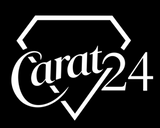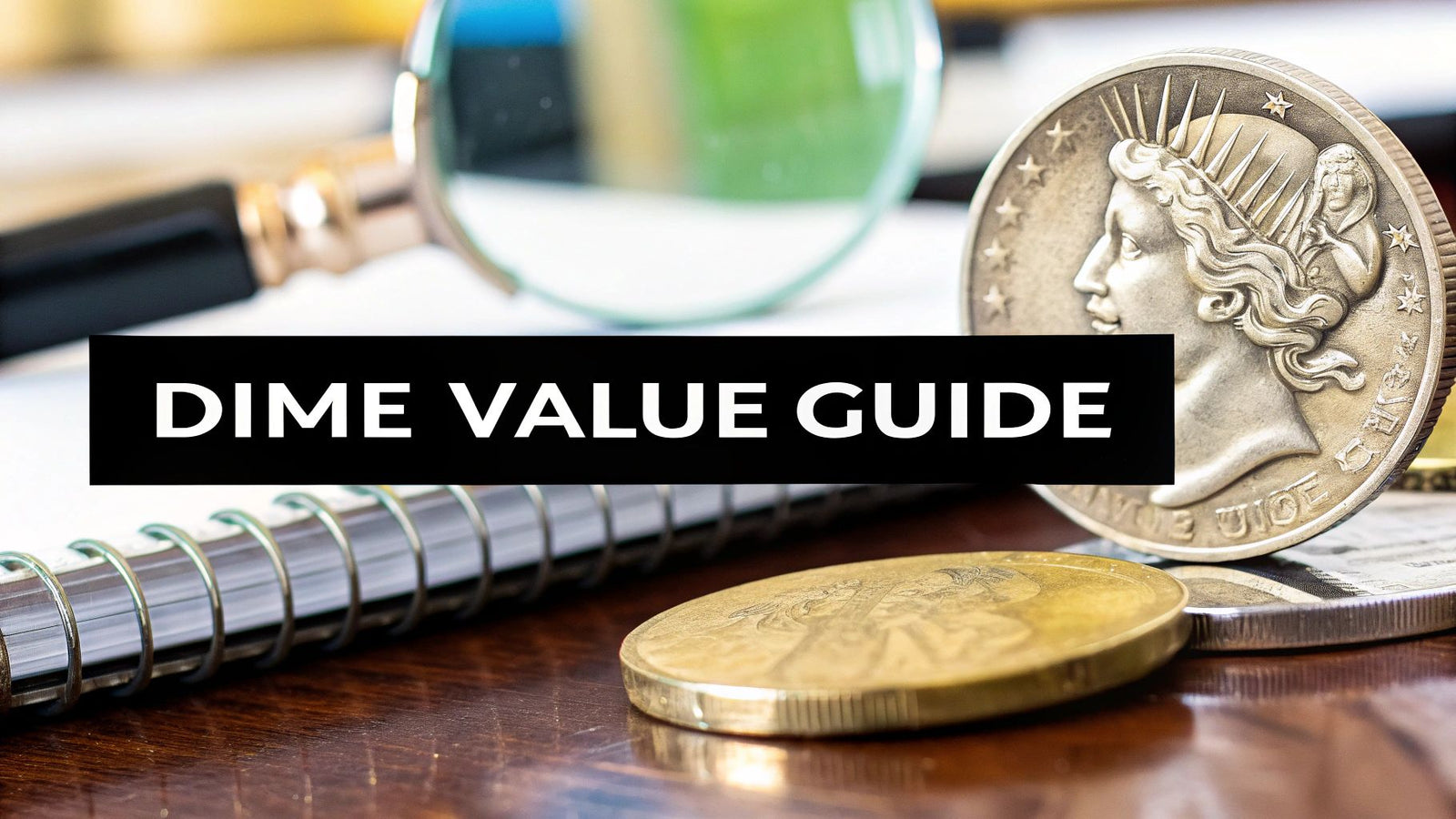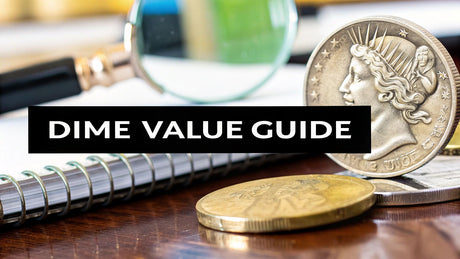Ever come across an old dime with a distinctive design and wondered if you've struck it rich? You just might have. Most of the old Liberty Head dimes you'll find—both the Barber and Mercury types—get their primary value from their 90% silver content. That usually puts them in the range of a few dollars.
But every now and then, you find one that's different. Certain dates, mint marks, or a coin in jaw-droppingly perfect condition can elevate it from a piece of silver to a collector's item worth hundreds, sometimes even thousands.
Your Instant Liberty Head Dime Value Check

So, you've got an old, silver-colored dime. Is it just pocket change from a bygone era or a hidden treasure? The answer isn't always straightforward, but figuring out what your Liberty Head dimes are worth is the first step on a pretty exciting journey.
While many of these coins trade hands based on their silver melt value, some rare examples command absolutely astonishing prices. The trick is learning to spot what makes a coin special. A heavily worn, common-date dime might just be worth a couple of bucks, but a rare "key-date" coin in that exact same condition could be a small fortune.
Common vs. Rare Dimes
Getting a handle on the basic value categories helps set your expectations straight. Most of the dimes you'll run into are considered "common," but it's the elusive "key dates" that collectors are always hunting for.
- Common Circulated Dimes: These are the workhorses. They were minted in huge numbers and saw plenty of action in people's pockets. Their value sticks pretty close to the daily price of silver.
- Key Date Dimes: Think of these as the limited editions. They were minted in much smaller quantities, like the legendary 1916-D Mercury dime, making them rare and valuable no matter how worn they are.
- Uncirculated Dimes: This is all about condition. A coin that never saw the inside of a cash register and still has its original shine can be incredibly valuable, even if it's a common date. Preservation is everything here.
Knowing the difference between a common coin and a key date is like knowing the difference between a regular production car and a limited-edition model—one is functional, the other is a collector's prize.
To give you a clearer picture, let's break down how these values can differ.
Liberty Head Dime Value at a Glance
This table offers a quick snapshot of what you can generally expect. "Circulated" means the coin shows wear from being used, while "Uncirculated" refers to a coin in pristine, like-new condition.
| Dime Type | Common Circulated Value | Key Date Circulated Value | High-Grade Uncirculated Value |
|---|---|---|---|
| Barber Dime | $2 - $4 | $50 - $1,500+ (e.g., 1895-O) | $100 - $10,000+ |
| Mercury Dime | $2 - $3 | $700 - $5,000+ (e.g., 1916-D) | $20 - $30,000+ |
As you can see, the jump from a common coin to a key date is massive. And if you have a key date in uncirculated condition? That's when you're talking about a truly significant find.
If you've got a pile of old coins and want to know their true value, bringing them to an expert is the best way to go. You can save the hassle and sell locally for more than online shipments. Here in Boise, we specialize in Gold and Jewelry Buying, and we're committed to offering the highest payout in Boise, backed by our Price Matching guarantee.
We offer Xray Scanning and Gold Testing for free to make sure you get a completely transparent and fair offer. Skip the uncertainty and get professional, hassle free offers today. For a deeper dive into a specific year, you can learn more about the 1912 dime value in our detailed guide.
So, Which Liberty Head Dime Do You Have?
When you’re trying to figure out what a Liberty Head dime is worth, the first thing to nail down is exactly which coin you’re holding. This gets a little confusing because "Liberty Head" actually describes two totally different, yet equally famous, American dimes. Each one comes from a distinct era and has its own story, which is why their values can be worlds apart.
Think of it like classic cars. You might have two cars from the same manufacturer, but a model from 1910 is going to have a completely different history, rarity, and collector appeal than one from 1940. Learning to spot the difference is the first real skill any coin collector needs to develop.
The Classic Barber Dime: 1892-1916
First up is the Barber Dime. It gets its name from its designer, Charles E. Barber, who was the Chief Engraver at the U.S. Mint at the time. This coin was a real workhorse, jingling in the pockets of Americans during the turn of the 20th century—a time of incredible industrial growth and change.
Its design is very formal and classic, showing Lady Liberty in a Roman-style profile. She's wearing what’s known as a Phrygian cap along with a laurel wreath. Since it was in circulation for nearly 25 years, most Barber Dimes you’ll come across today are pretty well-worn, and that wear and tear is a huge factor in what they’re worth.
The Celebrated Mercury Dime: 1916-1945
Right after the Barber dime came one of the most beloved designs in the history of U.S. coins: the Winged Liberty Head Dime. You’ll almost never hear it called that, though. Everyone knows it by its nickname, the "Mercury Dime."
The name came from a simple mistake. The winged cap on Lady Liberty’s head reminded people of Mercury, the speedy Roman messenger god, and the name just stuck. Designed by Adolph A. Weinman, this dime's gorgeous, artistic look became an instant American icon, capturing the optimistic spirit of a nation entering a new era.
The Mercury dime was minted for three decades, and a staggering 2.6 billion of them were made. That huge number means common-date coins in circulated condition are pretty easy to come by. But—and this is a big but—certain dates are incredibly rare. The famous 1916-D, for example, had a tiny mintage and can be worth thousands of dollars even in rough shape. You can discover more about the Mercury dime's fascinating value range on Greenlight.com.
Getting the identification right is the single most important step in figuring out what your coin is worth. A Barber dime and a Mercury dime from the same year can have wildly different values because their histories and collector demand are completely separate.
Whether you're just getting started or have been at this for years, knowing the story behind the coin makes the hunt that much more exciting. To kick off your own numismatic adventure, take a look at our guide on how to start a coin collecting hobby.
Unlocking Value with Dates and Mint Marks
So, what’s the difference between a common silver dime and a rare find that could be worth thousands? It often boils down to two tiny details every seasoned collector learns to check first: the date and the mint mark.
Think of them like the VIN number on a classic car. These little marks tell you exactly when and where the coin was made, which is the key to figuring out its rarity and, ultimately, its value.
For both Barber and Mercury dimes, the mint mark is a small letter that tells you its origin story. An “S” means it was struck in San Francisco. A “D” means it came from the Denver mint. If you don’t see a letter at all, that coin was produced at the main U.S. Mint in Philadelphia.
Knowing where to look is the first step in playing coin detective. This handy visual should get you started on identifying which Liberty Head dime you’re holding.
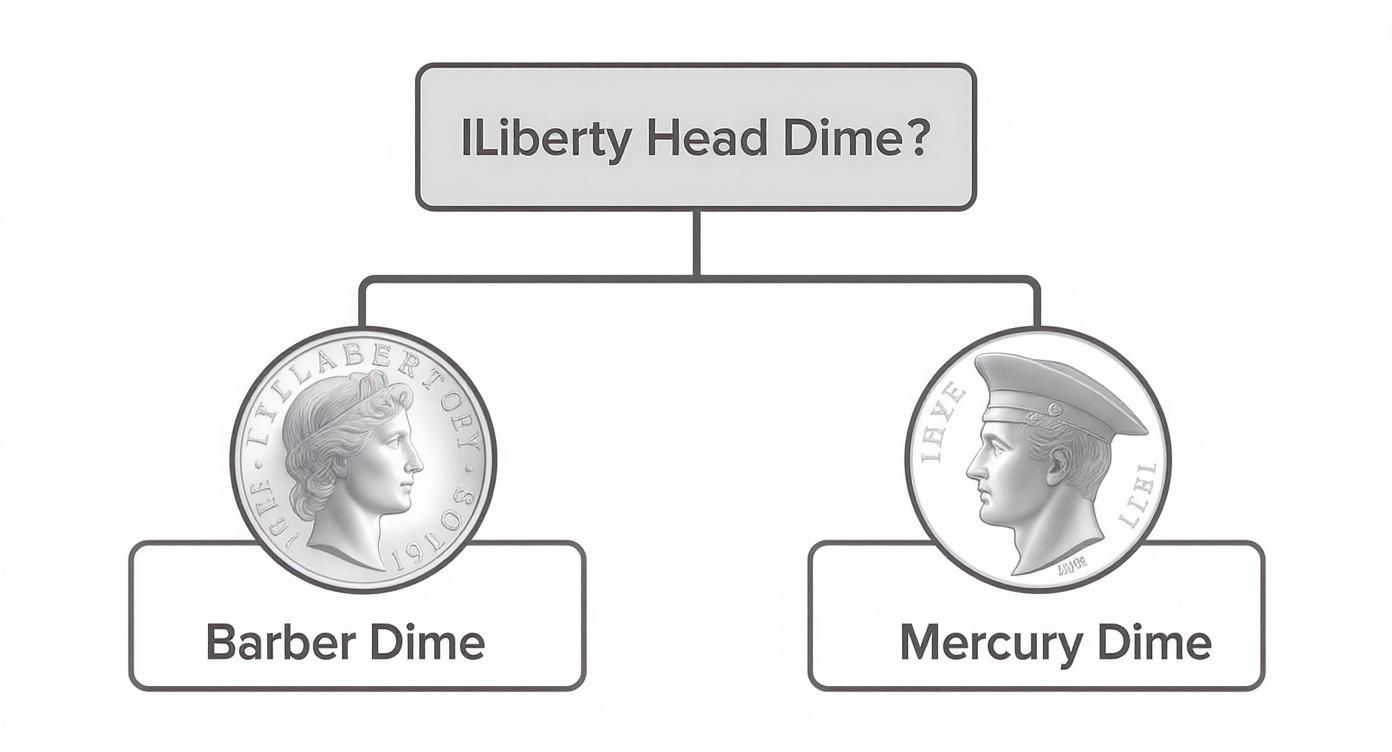
This guide helps you spot the difference between the classic Roman-style profile on the Barber dime and the famous winged cap of the Mercury dime. Once you know which one you have, finding that all-important mint mark is easy.
Where to Find the Mint Mark
Locating these crucial marks is straightforward once you know the right spot to check. The placement is different for each series, so make sure you’re looking in the correct place.
- Barber Dimes: Flip the coin over to the reverse (tails) side. You'll find the mint mark just below the wreath.
- Mercury Dimes: The mint mark is also on the reverse. Look to the left of the fasces (the bundle of rods with an axe) near the bottom edge of the coin.
Once you’ve found the mint mark—or confirmed there isn’t one—you can pair it with the date to see if you have a common coin or one of the prized “key dates.” Certain date-and-mint combinations were produced in very small numbers, making them the holy grails every collector dreams of finding.
We’re talking about legendary coins like the 1894-S Barber Dime and the iconic 1916-D Mercury Dime. If you want to learn more about spotting these older treasures, check out our guide on identifying valuable coins from 1964 and earlier.
A coin's date and mint mark combination is its unique fingerprint. Low production numbers from a specific mint in a specific year create the kind of scarcity that drives collector demand—and value—through the roof.
The difference in value can be absolutely staggering. The most valuable Mercury dimes usually have a tiny original mintage, a glaring minting error, or are a rare variety.
Take the legendary 1916-D, for example. Only 264,000 were ever made, and one holds an auction record of $207,000. Another stunner, the 1938-S, had a decent mintage, but so few survived in pristine condition that a single top-grade example sold for an incredible $364,250. These are the kinds of numbers that get a collector’s heart pounding.
How a Coin's Condition Multiplies Its Worth
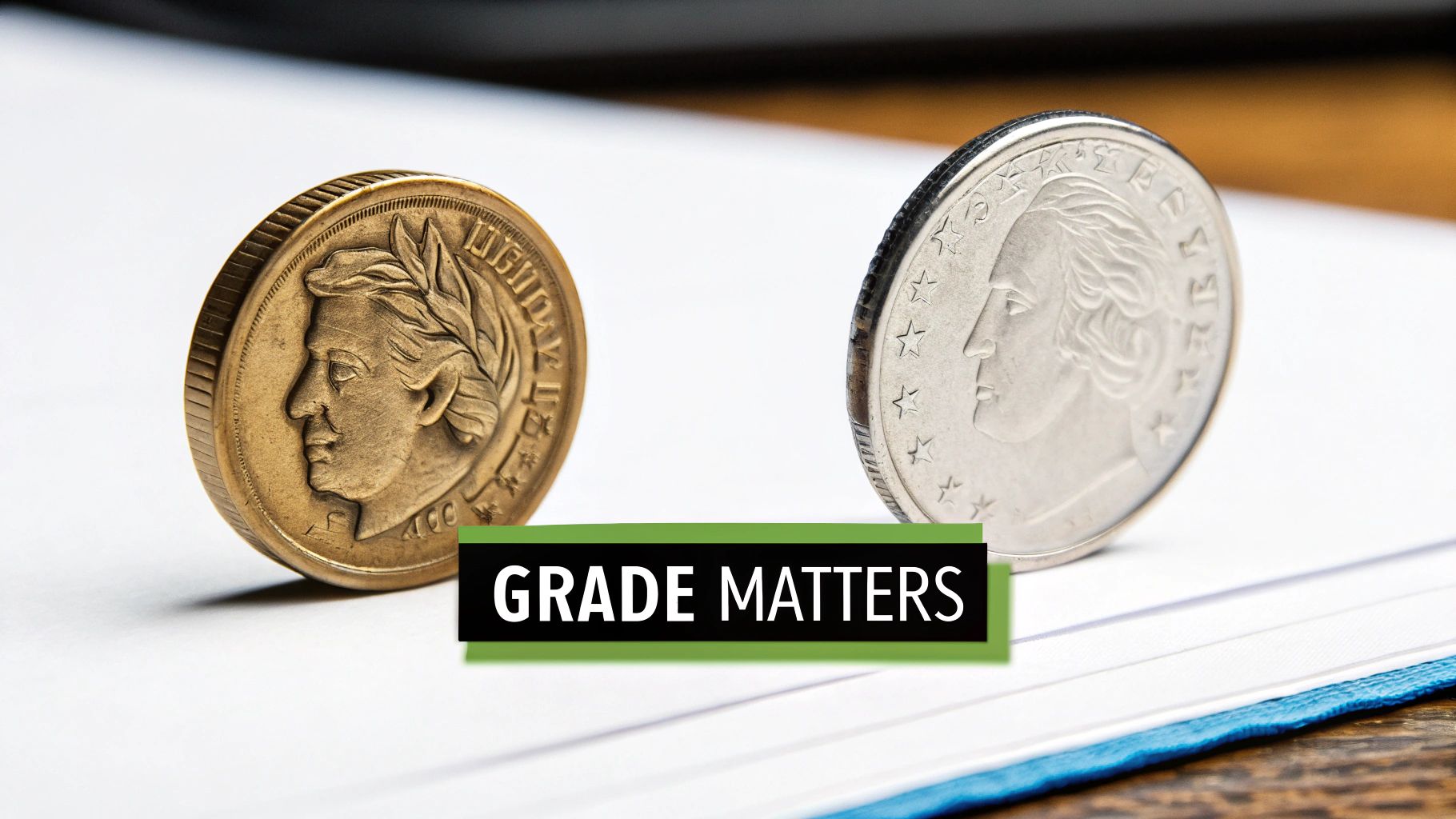
If a coin's date and mint mark tell you its story, then its condition tells you how well that story has been preserved. In the world of coin collecting, we call this "grade," and it's hands down the single biggest multiplier of value. A pristine, uncirculated coin can be worth exponentially more than an identical one that’s been worn smooth from years of rattling around in pockets.
Think of it like a vintage comic book. A copy that’s been read, folded, and passed around for decades is still a cool piece of history. But what about a copy that was sealed away the day it was printed and still looks brand new? That’s the one collectors will pay a massive premium for. It's the same exact principle with coins.
From Good to Uncirculated
Coin grading uses a specific scale to describe a coin's level of wear. While the official system has 70 distinct points, most collectors use broader, more common terms to quickly communicate a coin’s state.
Here’s a quick rundown:
- Good (G): The coin is heavily worn. You can still make out the main design and date, but most of the finer details have been smoothed out.
- Fine (F): There's still moderate wear, but more details are visible. The key design elements are much clearer than a "Good" coin.
- Extremely Fine (XF): Now we're getting somewhere. The coin shows only light wear on the highest points of the design and still has a lot of its original mint luster.
- Uncirculated (MS): This coin has zero signs of wear. It looks just as it did the day it left the mint, with a full, original shine.
The difference in value between these grades can be staggering. Take a common 1945 Philadelphia dime in Good condition—it's worth about $3. That very same coin in a brilliant Uncirculated state can easily jump to $15 or more. The better the preservation, the higher the price.
The Full Bands Game Changer
For Mercury dimes, there's another layer to grading that can make a coin's value absolutely skyrocket: the "Full Bands" (FB) designation. This refers to the three horizontal bands holding together the bundle of rods (a fasces) on the reverse of the coin.
On most dimes, these bands are weakly struck and tend to blend together. It's just a quirk of the manufacturing process from that era.
But when these bands are fully separated and sharply defined, it's proof that the coin was created from a fresh, perfectly struck die. Collectors prize this feature so much that an FB designation can multiply a coin's value many times over.
Condition is the defining factor, even for the most common dates. A 1917 Philadelphia Mercury dime in average circulated condition might be worth $4–$6. But find an uncirculated one with crisp Full Bands? Its value can increase by 200% to 1,000%.
Preserving this condition is obviously crucial. Protecting your collection from damage is the best way to protect your investment, and our guide on how to store silver coins can show you exactly how to do it right.
Selling Your Dimes for the Highest Payout
Once you have a good handle on what your Liberty Head dimes might be worth, the next step is figuring out how to turn that potential into actual cash in your pocket. It's a critical part of the process.
You might be tempted by the convenience of online marketplaces or mail-in services. On the surface, they seem easy. But they often come with hidden costs and serious risks you need to consider. Shipping valuable coins, paying for insurance, and then waiting for an offer from a buyer you've never met can be a pretty stressful experience.
You can save the hassle and sell locally for more than online shipments. A trusted local expert offers something mail-in services can't: a transparent, in-person evaluation that removes all the guesswork and uncertainty. This way, you’re not just a tracking number in a system; you're a valued client getting personalized, face-to-face service.
Why Selling Locally in Boise is Your Best Bet
Choosing a local buyer right here in Boise means you get immediate, professional attention from someone who knows the market. Instead of sending your collection into the void and hoping for the best, you can sit down with an expert who will assess your coins right in front of you. This is especially important for items that have both numismatic and precious metal value.
We specialize in Gold and Jewelry Buying and are completely committed to offering the highest payout in Boise. Our entire process is built to be transparent and stress-free for you.
- Free Xray Scanning and Gold Testing: We use state-of-the-art, non-destructive technology to verify the exact composition of your items without causing a scratch. This scientific approach ensures you get an accurate valuation based on real data, not guesswork.
- Hassle-Free Offers: Our evaluations are fast, free, and come with zero obligation. You'll get a clear, straightforward offer right on the spot.
- Price Matching: We're confident in our offers. If you happen to get a better written offer from another local competitor, we will match it.
Selling your valuables shouldn't be a gamble. Working with a local expert gives you the confidence of a secure transaction and the assurance that you're getting the best possible price for your items.
Deciding where to sell is a big deal, and it helps to see the options side-by-side. This table breaks down the key differences between sending your coins away versus keeping it local here in Boise.
Selling Online vs. Selling Locally in Boise
| Feature | Online/Mail-In Buyer | Local Boise Buyer |
|---|---|---|
| Evaluation | Done remotely, out of your sight | In-person, transparent, and immediate |
| Payment Speed | Days or weeks after shipping | Instant payment upon agreement |
| Shipping & Risk | You bear the cost and risk of loss | None; transaction is face-to-face |
| Offer Certainty | Offers can be lowered after inspection | Firm, hassle-free offers on the spot |
| Payout | Often lower due to overhead costs | The highest payout in Boise, with price matching |
As you can see, the local option provides a level of security and transparency that's hard to match.
Ultimately, knowing what your Liberty Head dimes are worth is only half the battle. Securing that value requires a partner you can trust. By choosing a local expert, you get peace of mind, a better price, and a far superior experience. To learn more about the process, check out our detailed guide on how to sell collectible coins.
Got Questions About Your Liberty Head Dimes? We Have Answers.
If you’ve ever found a handful of old silver dimes, you know the feeling. Questions start popping up immediately. You can tell they’re old and made of silver, but what does that really mean for their value? A little bit of knowledge can go a long way in helping you decide what to do with your collection.
A common one we hear is, "Are all old dimes silver?" The answer is simple: if a U.S. dime is dated 1964 or earlier, it’s made of 90% silver. That goes for every single Barber and Mercury dime ever minted. This silver content alone gives them an intrinsic value—often called "melt" value—meaning they are always worth more than just ten cents.
Another question that comes up all the time is about cleaning old coins. Should you do it? The answer from every single expert in the field is a hard no. Cleaning a collectible coin, even if you’re gentle, can strip away its original surface—the "patina"—and leave behind tiny, hairline scratches. This damage can absolutely tank its value to a collector, sometimes reducing a valuable coin to being worth only its weight in silver.
Is It Worth Getting My Dimes Graded?
This is a big one, because it’s a question that involves your money. Professional grading services, like PCGS or NGC, will authenticate your coin, assign it a numerical grade, and seal it in a protective case (or "slab"). While this official certification can make a coin’s value jump, the service itself isn't free—you're typically looking at $30 to $50 per coin, sometimes more.
So, when does it make sense to pull the trigger?
- For Key Dates: If you have a known rare coin, like the famous 1916-D Mercury dime or the holy grail 1894-S Barber dime, getting it professionally graded is almost always a smart move.
- For High-Condition Coins: Maybe you have a common-date coin, but it looks like it just rolled off the mint press. For pristine, uncirculated coins (especially a Mercury dime with sharp Full Bands), grading confirms its top-tier quality and unlocks its maximum market value.
- For Common, Worn Coins: It is almost never worth the cost to grade common-date dimes that are heavily worn. The grading fee would likely be more than the coin is worth, plain and simple.
Think of grading as a strategic investment. It’s for high-potential assets where the cost to certify it is just a small piece of the value you'll gain. For your everyday circulated coins, it’s an expense you can skip.
How Do I Sell My Dimes Safely?
Once you have a good idea of what you’re holding, the next step is selling—and you want that experience to be secure and profitable, whether it's coins, gold, or jewelry. You could go the online route, but that often means dealing with risks, shipping headaches, and the general uncertainty of sending your valuables to a faceless buyer.
The best approach? Save the hassle and sell locally for more than online shipments. A trusted local buyer gives you a transparent, face-to-face evaluation, offering total peace of mind.
At a reputable local shop, you get expert service right away. Here in Boise, we specialize in Gold and Jewelry Buying and are committed to giving you the highest payout in Boise. We keep everything transparent with free Xray Scanning and Gold Testing, so you know the exact makeup of what you have. Our entire process is built on trust, providing hassle-free offers and a Price Matching guarantee. You walk away with a fair, top-dollar offer on the spot—no risks, no waiting for a check in the mail. Selling locally isn't just safer; it's smarter.
Ready to discover the true value of your collection? Visit Carat 24 - Trusted Gold Experts in Boise for a free, no-obligation evaluation of your coins, gold, and jewelry. We offer the highest payouts, guaranteed. Find out more at https://carat24boise.com.
